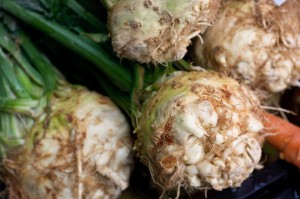
Tomatillos are the main ingredient in salsa verde. (C) uckyo/dollarphotoclub
As we wait for the big thaw and the dry out, I thought it would be fun to check with some gardeners throughout the area to see what vegetables they are dreaming about. Next week we’ll explore more common vegetables. Here are some less common faves:
Tomatillo
Last summer Ginny Roberts planted Botanical Interests’ Tomatillo Toma Verde, an heirloom. “Tomatillos are very easy to grow, hardy and prolific,” said Roberts, urban garden program assistant at Purdue-Marion County Extension.
“My husband and I enjoy using them in a variety of fresh salsas. We also make a wonderful sauce and freeze it. And, much to our pleasure, bees flock to the flowers until late fall.”

Tomatillos grow similarly to tomatoes, but are related to gooseberries. (C) ason/canstockphoto
Roberts started plants from seeds indoors and transplanted them outdoors. “I planted 18 and learned the hard way that they are heavy producers and can become space hogs. I will plant just six this year and fence them in. End of season clean up should include raking up any dropped fruit. Tomatillos will reseed, if given the opportunity!”

Leeks are easy to grow from seeds. Some garden centers and online retailers may have starts. (C) Max Straeten/morguefile
Leeks
Beautiful leaves and harvesting-as-needed make leeks attractive to Chris Turner, owner of uTopos Gardens, an Indianapolis gardening company. “I am not so good at harvesting vegetables that are time sensitive, such as tomatoes, so anything that can wait for me is my kind of vegetable!”
Sowing seeds was easy and less expensive than buying starts. “I put all the seed in one pot, and then teased the seedlings apart when it is time to plant in the garden,” he said. In the garden, he digs a 3-inch deep trench and sets the leek seedlings in the bottom. “As they grow I push the dirt back into the trench around the plants. This makes for longer white parts.”
Celeriac
“I like growing less common vegetables, and last season I enjoyed growing celeriac. Sometimes celeriac is called celery root,” said Fritz Nerding, manager of the Garfield Park Conservatory and Sunken Garden. “I grew the Diamant variety from John Scheepers Kitchen Garden Seeds. He sowed seeds indoors in February and transplanted seedlings outdoors about 12 weeks later.

Celeriac has a celery-like flavor. (C) ccat82/canstockphoto
He grew celeriac in rich garden soil amended with mushroom compost and rotted manure. “Celeriac requires more water than most garden plants, but the extra watering rewarded me with a fantastic celery-root stuffing for our Thanksgiving turkey.”